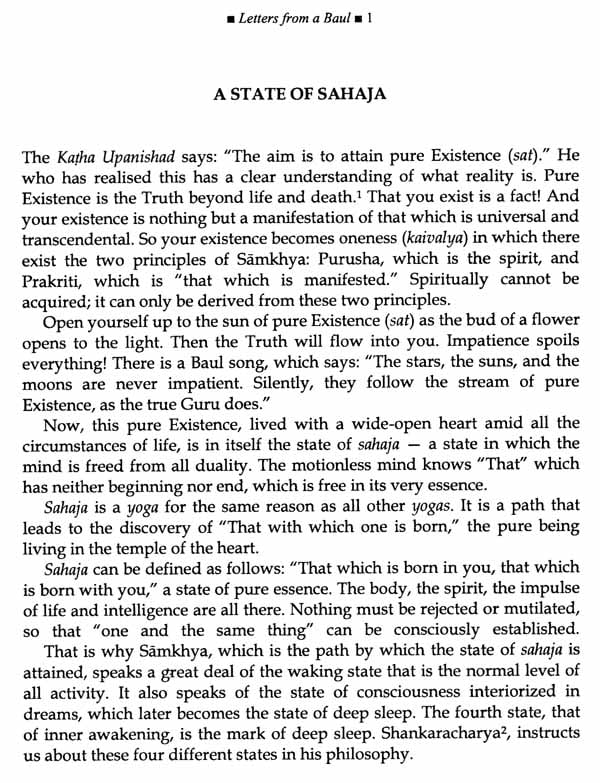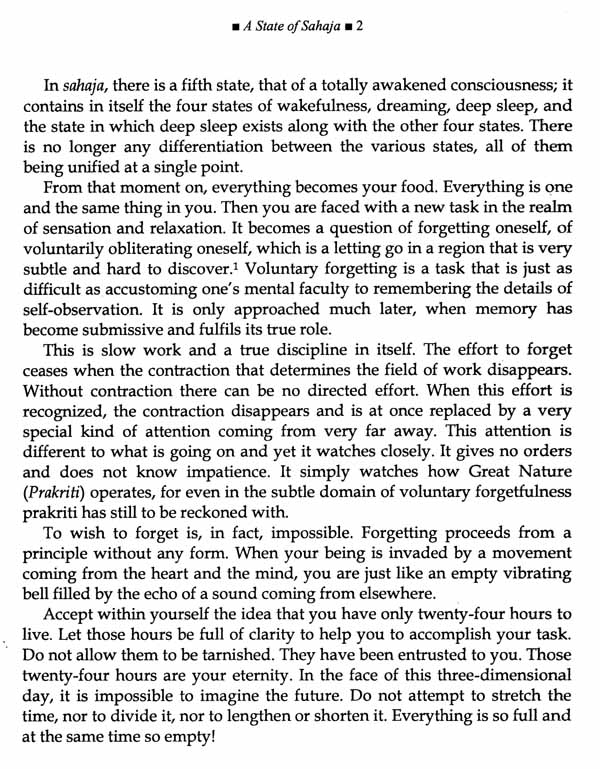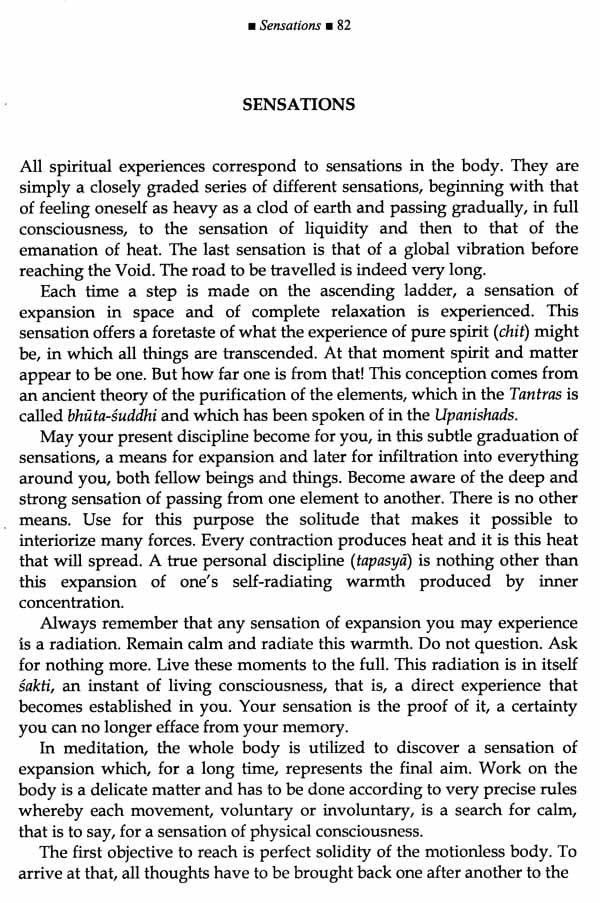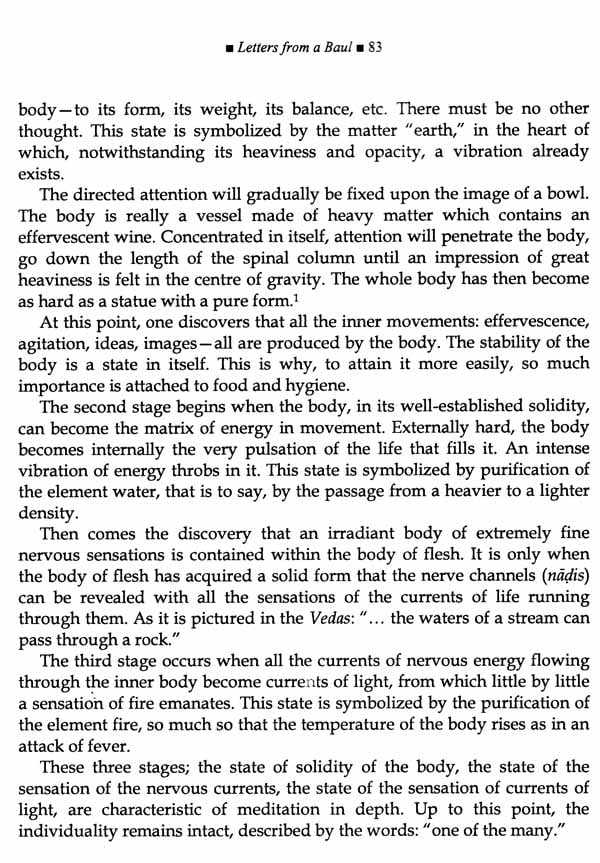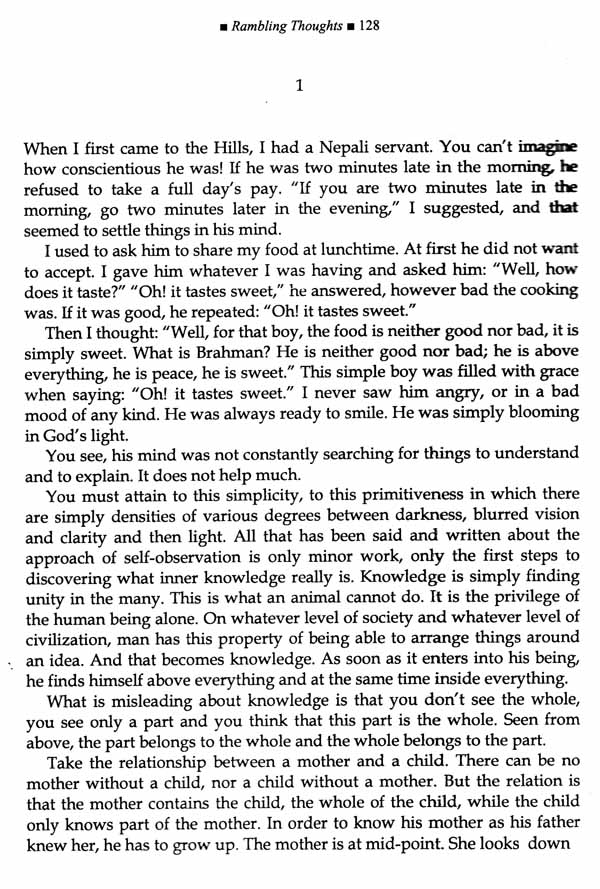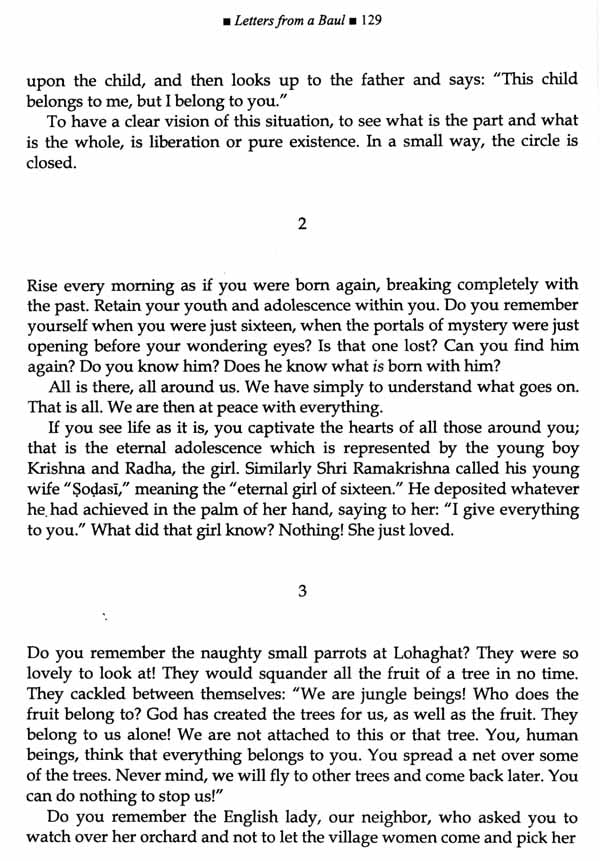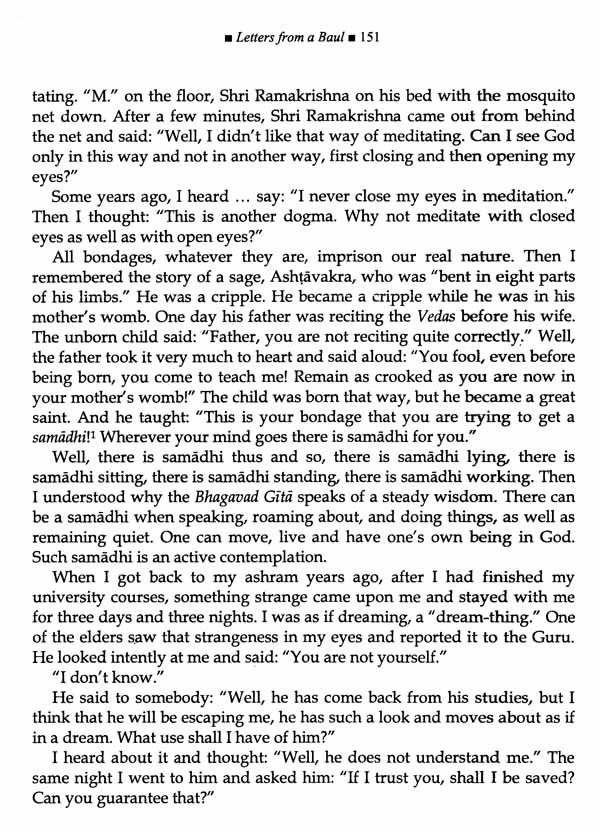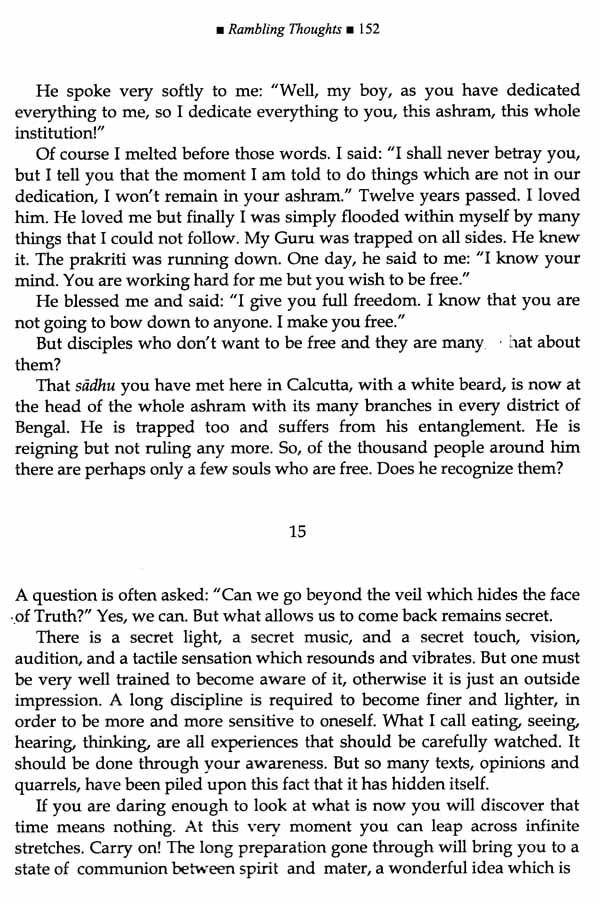
Letters from a Baul- Life Within Life
Book Specification
| Item Code: | NAY543 |
| Author: | Sri Anirvan |
| Publisher: | Overman Foundation, Kolkata |
| Language: | English |
| Edition: | 2018 |
| ISBN: | 9789383165531 |
| Pages: | 227 |
| Cover: | PAPERBACK |
| Other Details | 8.50 X 7.00 inch |
| Weight | 330 gm |
Book Description
Shrimat Anirvan (8 July 1896 -31 May 1978) had mastered the Astadhyayi of Panini at a very early age. After completing his formal education he renounced the world and joined the Kokilamukh Ashram at Jorhat (in Assam) founded by his Guru Swami Nigamananda Paramahamsa where he was given Sannyasa and he became Nirvanananda Saraswati. But after a few years he dropped the ochre robes and changed his name to Anirvan by which he became known to the world at large. He spent a number of years in Lohaghat (Almora) where Madame Lizelle Reymond, a Swiss spiritual seeker, joined him and literally took him to the West through her books My Life with a Brahmin Family and To Live Within. He later shifted to Shillong in Assam and finally to Kolkata where he spent his last years. His first book was a Bengali translation of Sri Aurobindo's The Life Divine which was described as a "living translation" by Sri Aurobindo himself and was published in two volumes between 1948 and 1951. Another sister-publication, Yoga-Samanvaya-Prasanga, based on Sri Aurobindo's The Synthesis of Yoga, was published in 1961. According to Ram Swarup: "In translating Sri Aurobindo's works, he was paying his debt to an elder brother and old friend from another life, as Shri Anirvan once said." But the centre of his studies was the Vedas on which he acquired a rare mastery over the years. His other published works include his magnum opus, Veda Mimamsa, (published in three volumes), upanisad-Prasanga (three volumes on Isa, Aitareya and the Kena), Gitanuvacana (three volumes), Vedanta Jijnasa and Pravacana (four volumes) to name a few.
This book consists chiefly of letters from Sri Anirvan to Lizelle Reymond and of recorded conversations that took place during their numerous meetings, in Almora, in Assam and Bengal. A few of Sri Anirvan's essays have been added, as well as "Rambling Thoughts" shared with his devoted students.
Before his death he read the present text carefully and revised it by shortening certain things or adding what he felt was needed to express better his own ideas. In his lifetime he neither taught nor wrote about his ideas in a dogmatic way but spoke very directly to seekers or passers-by who came to him with their problems, which filled their minds and hearts full of anxiety.
Sri Anirvan was a Baul, a solitary man with no ashram surrounding him, who received in exactly the same way a cloth-merchant from the near-by hamlet and a Member of Parliament residing in the District. His approach was very simple. He wanted no sign of veneration. He knew how to listen without haste, even when his available time was limited. One felt in him a widely cultured man, and this impression was heightened by his attitude of respect toward his visitors.
He always spoke with reference to the Science of Samkhya, not the philosophical Samkhya as taught by Vijnana Bhikshu in the 15th century, but that Samkhya which is the essence of life-like a pure Voice coming from the Vedas and the Upanishads, revealing a gnostic wisdom concerning the Fullness of Great Nature and the order of the Cosmic Laws. He made immediately clear to his visitors that to live in accordance with the Cosmic Laws, which are all-powerful, involves following a long course of inner discipline aimed at cultivating mental concentration and giving a right direction to the will. This wisdom is in fact a mystical approach which derives from the primal substance.
Sri Anirvan was a Bengali, born the eldest son of Sri Raj Chandra Dhar, in 1896, at Mymensing, in the Eastern part of the country. At the age of thirteen he already wanted to follow his father, who had joined the vast Ashram of Swami Nigamananda in Assam; but the Guru of that Ashram decided that he should have a university career in order to be able to serve the Saraswat Sangha to the best of his ability.
Accordingly he went from Dacca, where he first studied, to Calcutta University and there, in 1918, he got the title of Kavyatirtha, the highest degree in Vedic and Panini Grammars. His return to the Saraswat Sangha was a festive day for all the disciples. During each vacation that he spent at the Ashram, he had been for them all "the beloved poet" illuminating the talks of the Guru, and making the work on themselves seen like labouring on the land to bring forth a garden of fruits and flowers.
In time he became Swami Nirvanananda Saraswati and served his Guru faithfully. But after a number of years, one night - with the blessing of his Guru who knew that he would never bow to any other darshana - he left the Ashram with only his staff in hand.
As a Baul, he took the name of Anirvan. It was no doubt Nirvacaniya becoming, with an "a" privative, a-nir-vac-aniya, which corresponds syllable by syllable to in-ex-plic-able in English, the root meaning being clear in the former and figurative in the latter. In general, people called him "Maharaj," and those who knew him: "servant of the Rishis."
Although he never spoke of his past, through his letters we learn of some striking incidents in his life. As a Baul he simply disappeared, becoming a traditional wanderer through the Himalayas. He lived for some years in a cave at the foot of the Kamakhya Hill in Assam. Later he was discovered apparently as an anonymous "man walking through the market place." This was in Delhi where, while working as a tutor, he was translating the books of Rama Tirtha because he thought that the Bengali needed to listen to his voice. He was reputed to have become a consultant on many difficult philosophical problems posed by scriptures ranging from the Bhagavad Gita to the Gathas of old Iranian Prophets.
Still later, some people from Ranchi called on him for help. They wanted to have a few chapters of The Life Divine of Sri Aurobindo translated into Bengali. This huge work had been written originally in English. Fascinated as he was by the text, Sri Anirvan accepted on condition that their Guru, Sri Aurobindo, would agree. The result was that Sri Anirvan retired for four years to Almora in order to give his whole time to translating the entire work.
Against his will, many people, including refugees, knocked at his door. They harassed him so much that a very simple kind of life was organized around him to protect him; it was devoid of encouragements to stay!
When, in due course, Sri Anirvan came to translate the "Third Mandala of the Vedas," his work became even more intense. He needed more helpers as well as complete isolation. It was at this point that I, Lizelle Reymond, among a few others, came into his circle.
At first I felt completely disoriented. We lived near his dwelling in small houses near the forest. In complete solitude the importance of each action was evaluated and accepted as a model of inner discipline on a wider scale. The previous kind of work I had done had equipped me so all I had to do was simply to conform.
To meet him, to work with him, and to attend our gathering every evening to prepare the work of the next day, was an invaluable teaching in itself. At night, we sat around a bowl of rice and a cup of milk. Very little was said. But a real spiritual atmosphere was created. No formal teaching was given but an awareness within oneself became a definite part of one's being.
This stage of life, however, was not to last. We knew that one day he was going to say: "The work is over. I shall be gone in less than three days." And so it happened.
As a Baul he was a completely free man. All that remains are his letters, which contain the kind of advice a Baul can give:
"The days that you were here appear so soft through the fading light of the past. We can always flit away to the Infinite through the door of the inner being. Can the march over hills and dales ever end? Remember that expansion is not doing anything, it is only being and becoming. The Spirit is and the manifestation does. It grows from the centre outwards just like the sprouting of a seed, quiescent, and yet the initiator of all movement. Remember that you are both Spirit and manifestation in yourself. That is why I am repeating: Be yourself."
The book appears thanks to the Pathamandir of Calcutta whose members were intimately associated with Sri Anirvan. Whenever he came to the plains or stayed in Calcutta, he gave regular lectures and readings of The Life Divine, Savitri and Upanishads.
**Contents and Sample Pages**

